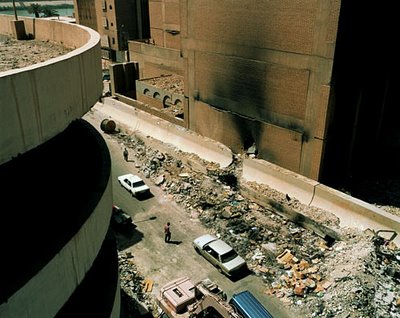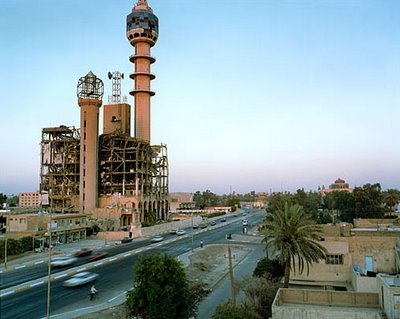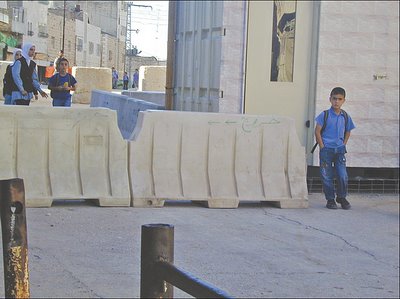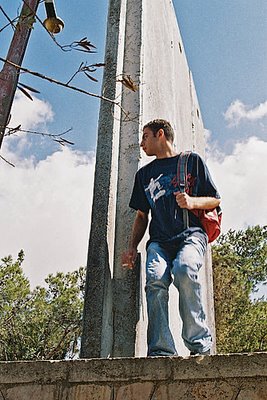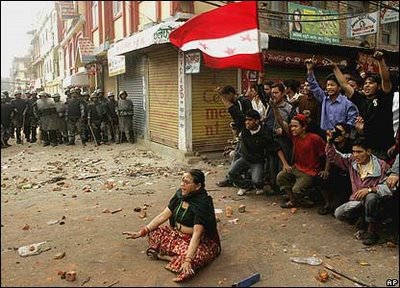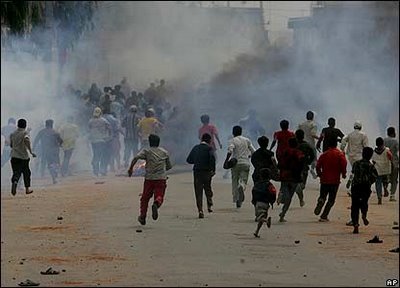
[Image: February 1, 1948 –
The Palestine Post Car Bombing. Photo – Central Zionist Archives Photo Archives.]
While scores of American soldiers, Iraqi security forces, and Shiite neighborhoods are permanently stalked by ‘the road to martyrdom’ of an insidious traffic war that haunts them in the streets of Iraq, via anonymous vehicles everyday (where roughly 1,300 car bombs have exploded in the last couple of years), the 80 year evolution of this ‘poor man’s air force’, as Mike Davis calls it, has reached a new apex today as the global insurgents’ weapon of choice.

[Image: "
'My Neck Is Thinner Than a Hair: A History of the Car Bomb' in the 1975-1991 Lebanese Wars" by
The Atlas Group.]
The
car bomb is now legitimately “comparable to airpower in its ability to knock out critical urban nodes and headquarters as well as terrorize the populations of entire cities,” he says, not to mention its effect “at destroying the moral credibility of a cause and alienating its mass base of support,” which is very similar to the way aerial bombardment campaigns have always functioned as a psychological weapon, demoralizing the enemy by having things hurled down at them from the sky.

[Image: "
'My Neck Is Thinner Than a Hair: A History of the Car Bomb' in the 1975-1991 Lebanese Wars" by
The Atlas Group.]
Thanks to the short history Davis so incisively documents in this
two-
part series for
Mother Jones, the car bomb is both the perfect literal and symbolic tool of a counter-empire military landscape; he points out that they’re extraordinarily cheap, stealthy, easy to organize, “inherently indiscriminate”, and leaves little forensic trace of culpability. Ultimately, he writes, "The car bomb is an inherently fascist weapon."
What I find interesting, though, is that the car -- a long time symbol of American brand freedom, and today perhaps the crude object of an American dependence on foreign oil -- has become the harbinger of this violent message, and made it, as
Charles Krauthammer has stated, “the nuclear weapon of guerrilla warfare."
The tale of how America's modern freedom horse became a new symbol for a global insurgency againt them, began with a horse-pulled cart packed with dynamite and iron slugs exploded outside the J.P.Morgan office headquarters in 1920. The vehicular weapon burst onto the scene as a device that was not only meant to kill, but also to get at the inner sanctums of capitalism in order to sabotage its financial ordering of the political structure. Since then, the car bomb has underwritten the geopolitical climate of terrorism around the world in what has now come to represent the ultimate “blowback” to American militarism.

[
Image: A Kashmiri peers into the windshield of an exploded vehicle after a car bomb went off in Srinegar.]
Davis traces the windy-road lineage of the car bomb from its use by the Jews, Christians, Hindus, the Tamil Tigers, assorted anarchists, French colonizers in Algiers, the mafia, the IRA, the British in their attempts to defeat Hezbollah in Lebanon, and last but not least, the CIA, who, during the 80’s trained the
mujahedin and gave them “malleable explosives to mount car-bomb and even camel-bomb attacks in Soviet-occupied cities. […] It was the greatest technology transfer of terrorist technique in history” says Davis. “There was no need for angry Islamists to take car-bomb extension courses from Hezbollah when they could matriculate in a CIA-supported urban-sabotage graduate program in Pakistan's frontier provinces.”

[Image:
BATF summary table illustrating the size and range of effectiveness of car bombs by vehicle type. -
Wikipedia.]
Davis cites
Steve Coll from his book
Ghost Wars who writes, "the vast training infrastructure” that the Americans helped to build “with the enormous budgets endorsed by NSDD-166 -- the specialized camps, the sabotage training manuals, the electronic bomb detonators, and so on -- would be referred to routinely in America as ‘terrorist infrastructure.'” And so, as seemingly with much of the legacy of U.S. military conquest, the Americans have essentially put into place the very pieces of the puzzle that have led to the asymmetric nature of today's conflict againt them which Davis describes as uniquely characteristic of the millennium.

[
Image: Photo essay on Bagdhad Explosions outide the "Green Zone".]
Now, with car bomb attacks rising dramatically around the world (which are virtually impossible to defend against) not only does the urban space of these target zones become a vastly different playing field (where the Americans are found retreating into the medieval enclaves of the
“green zone” guarded by huge blast walls and layers of concrete barrier), but the urban space of the West’s own cities now, too, become surreptitiously vulnerable. City planners don their military strategist uniforms to figure how to turn their precious gems of modern civilization into proto-militant urban fortresses which are, ironically enough, already infiltrated by the world’s most sophisticated road networks that seem to just be lying around in wait for the delivery of eventual car bomb attacks.

[
Image: Photo essay on Bagdhad Explosions outide the "Green Zone".]
In a forthcoming article entitled
'Cities and the 'War on Terror', professor
Stephen Graham indicts the production of a military urbanism as a “securitized ‘inside’ enclosing the urban places of the U.S. Empire’s ‘homeland,’ and an urbanizing ‘outside,’ where U.S. military power can preemptively attack places deemed sources of terrorist threat.” He argues that the Bush doctrine of the 'War on Terror' has constructed a "binary portrayal" of separate places, distant cities, "imaginative geographies" between the West and the
untamed Arab world, (or, the sort of urban spatial equivalents of 'Us vs. Them') that are militarily treated together as a single “’integrated battlespace’ prone to rapid movements of ‘terrorist’ threats into the geographical and urban heartlands of U.S. power at any instant.”; a projected battlespace that re-images 'Homeland Cities' as a network of 'National Security Spaces.'
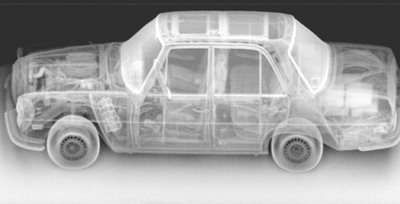
[Image:
Z Backscatter Image Reveals Car Bomb]
Davis goes onto to discuss how police snipers in London have been rapidly replaced by a omnipotent watch over the streets with thousands of CCTV cameras, making the UK's capital the most surveilled space perhaps in the world. While this type of surveillance may help to identify and apprehend non-suicidal suspects, it doesn't do jack against car bombers. Fearnig Bagdhad may serve as
a metaphor for our collective urban future, he concludes his article in part with this rather painfully obvious statement: “until some miracle technology emerges (and none is in sight) that allows authorities from a distance to "sniff" a molecule or two of explosive in a stream of rush-hour traffic, the car bombers will continue to commute to work.”
Anyway, Davis’ article is a precursor for a larger book he’s writing on the subject, and will also appear in another book due out next year,
Indefensible Space: The Architecture of the National Insecurity State, edited by
Michael Sorkin. So, keep your eyes peeled.








